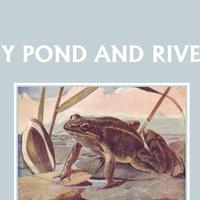CHAPTER 12. PEGGY'S WATER-PLANTS
WHEN Wednesday came, Peggy's pan was ready. She had taken it to the pond and dipped it gently under the duckweed. She brought it up quite full, and picked it over very carefully, leaving only the best plants. Then she carried it to the show-room.
There she put the yellow lily into the middle of the pan, so that the flower, and the stalk with the seed-vessel, fitted into the hollow between the ears of the large green leaf just at the leaf-stalk. Next she put pieces of the water-crowfoot here and there, the pretty white blossoms streaked with yellow resting upon the top of the water.
She stuck two spikes of bog-bean, with their leaves, one on each side of the water-lily. Lastly, she put spikes of the water-milfoil round the edge of the pan. Their leaves made little green stars in the water all the way round, and their tiny pink flower-spikes made a lovely edge.
Then she wrote her card. This is what she said:
1. The yellow water-lily grows in the pond near the farm. It has a thick stem rooted in the mud down at the bottom. I saw it once when they cleaned the pond. We see nothing on top of the water in March. But in May the large shining green leaves have grown to the top of the water on long stalks. They are shaped rather like heart, but are pointed at the tip.
In June the buds come up. They are like green knobs tipped with yellow. But as they grow bigger, the five outer leaves, or sepals, open, and they are quite yellow inside. Then we can see the small inner flower-leaves, or petals, arranged in two rows; after them come a number of stamens, made of thin threads, with dust-bags on the top. Then right in the middle is the seed-box, or ovary. It is shaped like a water-bottle with a round cushion on the top, and has a number of sticky points, which lie on the cushion in the shape of a star. Little beetles are often found in the flowers. They fly in, and suck the honey at the back of the petals.
2. The water-crowfoot grows in our pond. It is a kind of buttercup. It has five outer green leaves, or sepals. They turn back against the stem when the flower is open. They often fall off. There are five white petals. They are streaked with yellow near the middle of the flower, where there are drops of honey. After the petals, come many stamens, and then, in the middle of the flower, a number of seed-boxes, each with one seed inside.
The water-crowfoot has two kinds of leaves. The leaves which float on top of the water are flat and cut into three half rounds. The leaves under water are cut into threads and spread out on all sides.
3. There is a great deal of duckweed in our pond. Each plant has one little root in the water and a kind of stem at the top. It has no leaves. The tiny flowers sometimes come out of a slit in the side of the stem. Each flower is nothing but two dust-spikes and a tiny seed-box.
4. The bog-bean, or duck-bean, is nearly out of flower now. It grows at the edge of the pond , and its leaves are cut into three long parts. The pinkish flowers stand out on little stalks upon a tall stem. They are cup-shaped, with five points, and have a number of white hairs inside.
5. The water-milfoil grows almost all under water. Only the small pink flowers stand in a spike out in the air. The flowers at the top of the spike have only stamens in them. Lower down some have both dust-bags and seed-boxes. The ones at the bottom have seed-boxes, or ovaries, only. Milfoil leaves are narrow, like grass, but quite short. They stand round the stem like the spokes of a wheel, or the rays of a star.
Peggy's water-nosegay and show-card won the prize.

